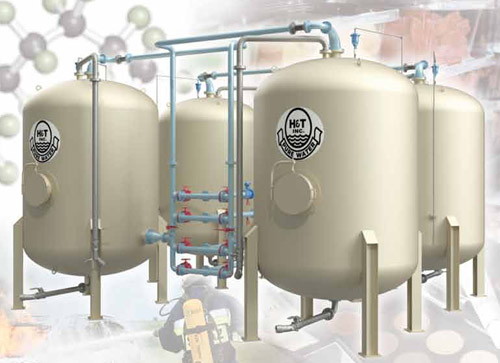The Future in PFAS Waste Management Methods for Environmental Protection
The Future in PFAS Waste Management Methods for Environmental Protection
Blog Article
Innovative PFAS Treatment Solutions for Safer Water
The boosting occurrence of PFAS contamination in water products demands a critical assessment of innovative therapy remedies. In addition, emerging bioremediation techniques offer a more lasting technique to tackling PFAS difficulties. pfas management.
Review of PFAS Contamination
PFAS contamination has actually emerged as a considerable ecological and public health issue. Per- and polyfluoroalkyl compounds (PFAS) are a group of artificial chemicals known for their determination in the setting and body, leading them to be commonly described as "permanently chemicals." These substances have been extensively utilized in various markets, including firefighting foams, water-repellent materials, and food product packaging, mostly due to their water- and grease-resistant buildings.
The extensive usage of PFAS has led to their detection in dirt, water products, and even in the blood of people and animals. Research studies have actually connected PFAS exposure to numerous health and wellness problems, including developmental impacts in babies, immune system dysfunction, and numerous forms of cancer cells. Additionally, the environmental persistence of these compounds complicates their deterioration and removal, elevating concerns regarding lasting eco-friendly effects.
Governing bodies are increasingly implementing rigorous standards to monitor and minimize PFAS degrees in drinking water and other ecological tools. As recognition of PFAS contamination expands, it has actually ended up being crucial for neighborhoods and markets to look for efficient therapy remedies to reduce exposure and protect public health.
Advanced Filtering Technologies
As the necessity to deal with PFAS contamination increases, advanced filtering innovations have actually emerged as a crucial part in the removal efforts targeted at getting rid of these consistent chemicals from water sources. These modern technologies leverage innovative systems to efficiently target and catch PFAS substances, which are infamously resistant to standard therapy techniques.
Among one of the most promising techniques is the usage of granular triggered carbon (GAC), which adsorbs PFAS particles as a result of its high surface and porous structure. This method has been extensively applied in both community and industrial setups, showing substantial decreases in PFAS focus. Furthermore, ion exchange resins have actually acquired grip, particularly designed to precisely bind PFAS ions from water, hence promoting their elimination.
Membrane layer purification innovations, such as reverse osmosis and nanofiltration, likewise reveal efficiency in PFAS elimination by physically dividing contaminants from water - pfas management. These systems can accomplish high levels of purity, making them suitable for alcohol consumption water applications
Chemical Therapy Developments
Various chemical therapy developments are being discovered to properly deal with PFAS contamination in water products. One appealing approach includes making use of advanced oxidation processes (AOPs), which make use of powerful oxidants such as ozone, hydrogen peroxide, or chlorine dioxide combined with UV light to break down PFAS substances into much less hazardous substances. This technique has shown efficiency in lab settings, showing potential for scalability in real-world applications.
An additional ingenious approach is the advancement of ion-exchange materials particularly developed to target PFAS. These materials can uniquely adsorb PFAS compounds from water, enabling their removal during treatment processes. Recent advancements have actually enhanced the efficiency and ability of these materials, making them a favorable choice for water therapy centers.
Additionally, researchers are checking out the use of chemical agents like persulfate and ferrous ions to improve the destruction of PFAS in contaminated water. These agents can cause chain reaction that help with the failure of relentless PFAS substances.
Emerging Bioremediation Methods
Recent improvements in chemical treatment developments have paved the way for discovering bioremediation methods as a practical alternative for attending to PFAS contamination. Bioremediation uses the natural metabolic procedures of microbes to deteriorate or change toxins, making it an attractive strategy for dealing with relentless click this contaminants like PFAS.
Arising methods in bioremediation include making use of genetically engineered bacteria that can specifically target and damage down PFAS compounds. These microbial pressures are being established for their boosted destruction capabilities, increasing the effectiveness of the removal process. Additionally, researchers are investigating the possibility of plant-assisted bioremediation, where specific plant types might uptake and sequester PFAS from polluted dirt and water.
An additional promising strategy is the application of bioaugmentation, which includes presenting helpful microbes into contaminated atmospheres to improve the deterioration of PFAS. This technique can promote faster remediation timelines and boost overall efficiency.

Regulative Frameworks and Specifications
A thorough governing structure is essential for efficiently handling PFAS contamination and guaranteeing public health and wellness security. The boosting acknowledgment of per- and polyfluoroalkyl materials (PFAS) as sites toxic wastes has actually motivated various government and state agencies to establish requirements that control their presence in water products. The United State Environmental Defense Firm (EPA) has actually developed health and wellness advisories and is pursuing setting enforceable limits for PFAS in alcohol consumption water.
State-level laws differ dramatically, with some states embracing stricter guidelines than those recommended by the EPA. These laws usually consist of maximum contaminant levels (MCLs) for details PFAS substances, tracking requirements, and reporting obligations for water energies. In addition, arising frameworks focus on the remediation of contaminated websites, highlighting the need for effective therapy innovations.

Final Thought
To conclude, the growth and implementation of cutting-edge PFAS treatment options are important for attending to the prevalent issue of water contamination. Advanced filtration technologies, chemical treatments, and emerging bioremediation techniques collectively present a multifaceted approach to properly decrease and degrade PFAS levels. As regulative frameworks remain to progress, integrating these modern technologies will be essential to guard public health and wellness and recover the stability of contaminated water resources, eventually adding to a cleaner and much safer environment.
Report this page